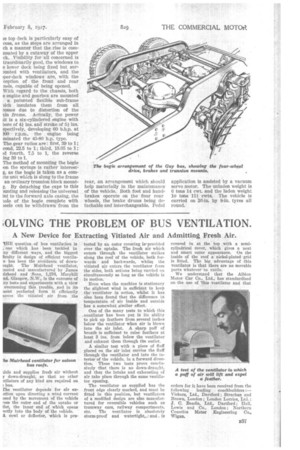OLVING THE PROBLEM OF BUS VENTILATION.
Page 135

If you've noticed an error in this article please click here to report it so we can fix it.
A New Device for Extracting Vitiated Air and Admitting Fresh Air.
1HE question of bus ventilation is one which has been tackled in ity different ways, and the biggest acuity in design of efficient ventilau has been the avoidance of downtught. The Muirhead ventilator, tented and 'manufactured by James iirhead and Bons, 1,276, Ilraryhill ad, Glasgow,.N.W., is the outcome of fly tests and experiments with a view overcoming this trouble, and in its :.sent perfected form it efficiently 'loves the vitiated air from the iicle and supplies fresh air -without y down-draught, so that no other itilators of any kind are required on bus.
rhe ventilator depends for air exLction upon directing a wind current used by the movement of the vehicle miss the outer end of the uptake or tlet, the inner end of which, opens ectly into the body of the vehicle. A. cowl or deflector, which is pro tected by an outer covering is-provided over the uptake. The fresh air which enters through the ventilator strikes along the roof of the vehicle, both forwards and backwards, whilst the vitiated air enters the ventilator from the sides, both actions being carried on simultaneously so long as the vehicle is in motion.
Even when the machine is stationary the slightest wind is sufficient to keep the ventilator in action, whilst it has also been found that the difference in temperature of air inside and outside has a somewhat similar effect.
One of the many tests to which this -ventilator has been put is its ability to pick up feathers from several inches below the ventilator when air is blown into the air inlet. A sharp puff of breath is sufficient to raise feathers at least 3 ins, from below the ventilator and exhaust them thnongh th'e outlet.
A similar test with a piece of fluff placed on the air inlet carries the fluff through the ventilator and into the interior of the vehicle, in a forward direction. These two tests prove conclusively that there is no down-draught, and that the intake and exhausting of air take place through the same ventilator opening,
The ventilator as supplied has the front edge clearly marked, and must be fitted in this position, but ventilators of a modified design are also manufactured for reversible vehicles such as tramway cars, railway compartments, etc. TN ventilator is absolutely storm-proof and watertight,“' and is covered in at the top with a semicylindrical cover, which gives a neat and smart outer appearance. On the inside of the roof a nickel-plated grid is fitted. The big advantage of this ventilator is that there are no movable Parts whatever to rattle.
We understand that the Albion Motor Car Co., Ltd., has standardized on the use of 'this ventilator and that orders for it have been received from the
following leading coachbuilders :— Vickers, Ltd., Dartford; Strachan and Brown, London ; London Lorries, Ltd.; J'. C. Beadle, Ltd., Dartford ; Hall, Lewis and Co., London; Northern Counties Motor Engineering Co., Wigan.




































































































































































































